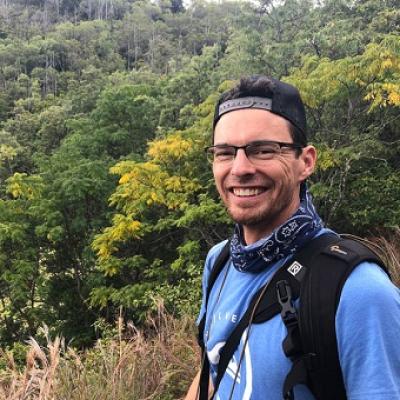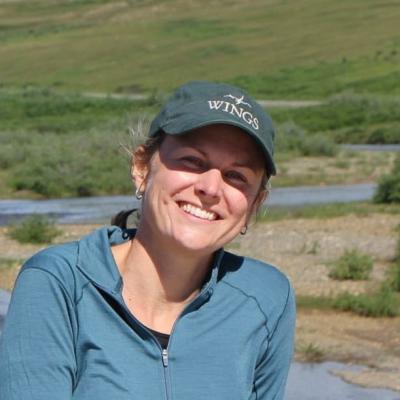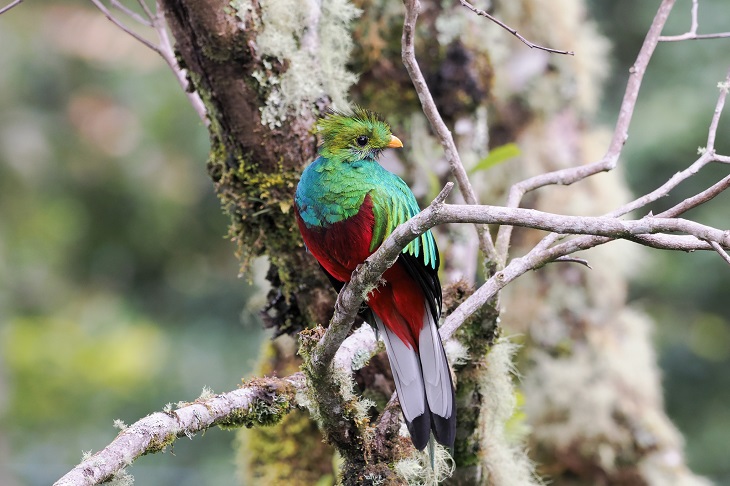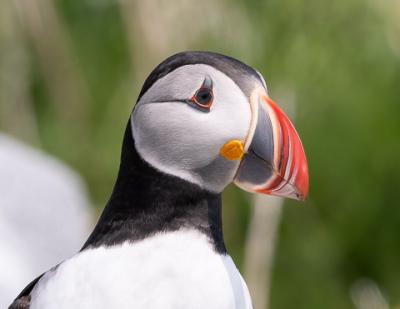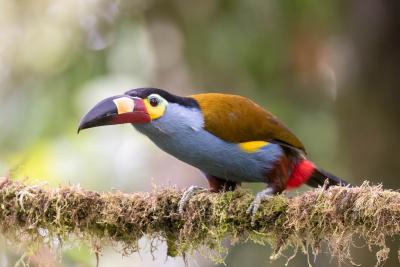Costa Rica in July
-
Jul 8-19, 2026
Scott Olmstead
2026
Single Room Supplement $410
2026
Single Room Supplement $410
Costa Rica packs more biodiversity within its borders than seems possible. A central spine of mountain ranges creates contrasting Pacific and Caribbean slopes, while ocean currents and prevailing winds create a drier north and wetter south. This complex geography produces an off-the-charts species richness for a country of its size. When you combine the abundant birdlife with the well-developed tourism infrastructure, the result is a seemingly infinite variety of birding locations that can be visited with logistical ease. One of the greatest challenges with planning a birding trip to Costa Rica is deciding where to go! On this trip we’ll concentrate on exploring the country’s north, with visits to such famous birding destinations as Rancho Naturalista, La Selva Biological Station, and Monteverde. Midsummer is a fascinating time in Costa Rica: rain can be frequent but falls mostly later in the day or at night, and temperatures are quite a bit cooler than in the spring; it’s the post-breeding season for most birds, meaning our trip coincides with peak numbers; finally, the press of tourists is much reduced from the peak winter season.
Day 1: The tour begins this evening at our hotel just outside San José. Night in Heredia.
Day 2: We’ll depart the San José metropolitan area early and bird our way toward Rancho Naturalista, our base for the next three nights. Stops along the way will give us a chance to get to know many of the common birds of Costa Rica’s Central Valley like Lesson’s Motmot, Squirrel Cuckoo, Barred Antshrike, Orange-billed Nightingale-Thrush, and Chestnut-capped Warbler. After arriving at our lodge we’ll look to see if the lovely Snowcap is visiting the flowering shrubs around the cabins. Night Rancho Naturalista.
Days 3-4: We have two full days to take advantage of the many birding sites located in close proximity to Rancho Naturalista, including the lodge property itself. On one morning we’ll begin the day on the deck listening to the dawn chorus and watching birds such as lanky Gray-headed Chachalacas, noisy Chestnut-headed Oropendolas, and colorful Collared Aracaris visit the feeders below while the hummingbird feeders at eye level are abuzz with the activity of White-necked Jacobins, Green-breasted Mangos, and others. One day we’ll set out early to visit a nearby site with extensive forest where we should find a wide variety of foothill species, including Tawny-crested Tanager, White-ruffed Manakin, Rufous Mourner, and Ashy-throated Chlorospingus. Several antbirds are possible, with Spotted, Bicolored, Dull-mantled and Zeledon’s among the options. With luck we might even see something truly rare and elusive like a Lanceolated Monklet or Yellow-eared Toucanet. We’ll also bird a picturesque river valley close to the lodge where mixed flocks often include Black-and-yellow and Emerald Tanagers, and the one-of-a-kind Sunbittern can sometimes be found foraging right at the edge of the road. A unique feature of Rancho Naturalista are the hummingbird bathing pools where one can watch Crowned Woodnymphs, Purple-crowned Fairies, and Snowcaps dipping into the creek below. We will certainly spend a little time exploring the trails at Rancho, which begin right outside our rooms and can produce forest species like Fawn-throated Foliage-gleaner, Red-throated Ant-tanager, Black-headed Antthrush, and the local Tawny-chested Flycatcher, sometimes found right around the lodge but can be quite shy. Nights at Rancho Naturalista.
Days 5-6: After another chance to enjoy the activity at the feeders from the balcony of our lodge, we’ll descend the Reventazon Valley to the Caribbean lowlands and towards the Sarapiquí region. We’ll visit local artist and naturalist “Cope,” who has turned his home into a miniature wildlife refuge featuring very productive fruit and hummingbird feeders often loaded with Red-legged Honeycreepers and Orange-chinned Parakeets, and a beautiful water feature sometimes visited by a pair of Russet-naped Wood-Rails. We’ll also spend some time searching with Cope for roosting owls; Crested and Spectacled Owls are both possible. The main event of our time in the lowlands will be La Selva, a biological station operated by the Organization for Tropical Studies. This roughly 1,400-acre reserve is adjacent to Braulio Carrillo National Park and is managed as a natural research laboratory. About 475 species of birds have been recorded at La Selva, and although we won’t see nearly that many in a one-day visit, we’ll certainly experience the avian richness of the region. La Selva is an excellent place to see Great Tinamou, Rufous and Broad-billed Motmots, Keel-billed and Yellow-throated Toucans, Black-crowned and Fasciated Antshrikes, Slaty-tailed and Gartered Trogons, Snowy Cotinga, Great Green and Scarlet Macaws, Stripe-breasted and Black-throated Wrens, and Chestnut-colored, Cinnamon, and Rufous-winged Woodpeckers, among many, many others. Our visit to La Selva will be an especially memorable part of the trip. We’ll also take a boat trip on the Sarapiquí River to look for kingfishers, tiger-herons, and the uncommon and timid Sungrebe. Nights in the Sarapiquí region.
Day 7: We’ll have another morning to look for anything we haven’t seen yet in the Sarapiquí region before heading up into the mountains, driving alongside a dramatic valley where Short-tailed and White Hawks are regularly seen. We’ll visit a middle-elevation site with feeders that attract crowd-pleasers like Prong-billed Barbet, Northern Emerald-Toucanet, Silver-throated Tanager, and hummingbirds such as Brown Violetear, Coppery-headed Emerald, and the flashy Violet Sabrewing before settling into our hotel for one night. Night in Vara Blanca.
Day 8: This morning’s birding in the Vara Blanca/Poasito area will offer refreshingly cool temperatures and the chance to see some high-elevation species that won’t be available anywhere else on the tour. The birding starts right on the grounds of our hotel, where we can find Ruddy-capped Nightingale-Thrush, Yellow-thighed Brushfinch, Slaty Flowerpiercer, and others. In patches of cloud forest on the slopes of Poás Volcano we’ll search for mixed flocks that can include Spot-crowned Woodcreeper, Flame-throated Warbler, Yellow-winged Vireo, and the endearing Collared Redstart. Among the new hummingbirds available here are Purple-throated Mountain-gem, Lesser Violetear, and Talamanca, Fiery-throated, Stripe-tailed, Scintillant, and Volcano Hummingbirds. Both Long-tailed and Black-and-yellow Silky-flycatchers are possible. In the afternoon we’ll travel west to Monteverde in the Tilarán Mountains — the longest drive of the trip at a little more than three hours — arriving in time for dinner. Night in Monteverde.
Days 9-10: We’ll have two full days to explore the varied habitats around Monteverde, one of Costa Rica’s original ecotourism destinations. Situated almost right on the continental divide, here we can find a fascinating mix of species from different regions within a relatively small area. One morning we’ll visit the lush, windswept forests of the Santa Elena Cloud Forest Reserve. Here we’ll target typical cloud forest species like Ruddy Treerunner, Spangle-cheeked Tanager, Gray-breasted Wood-Wren, Red-faced Spinetail, Slaty-backed Nightingale-Thrush, and the skulky Silver-throated Tapaculo. If we are lucky we might spot a Buff-fronted Tinamou, Highland Tinamou, or covey of Black-breasted Wood-Quail crossing the trail. We’ll also hit the productive middle-elevation Curi-Cancha Reserve, a great location to look for the iconic Resplendent Quetzal. Mixed flocks at Curi-Cancha can contain Slaty Antwren, Plain Antvireo, Spotted Barbtail, Costa Rican Warbler, and Olivaceous and Spotted Woodcreepers. Fruiting trees may attract Golden-browed Chlorophonia, Elegant Euphonia, Mountain Thrush, and Scarlet-thighed Dacnis. Monteverde is one of the best places to find the Three-wattled Bellbird, a strange member of the cotinga family with an ear-shatteringly loud voice, and we’ll be sure to make a special effort to see this species. One afternoon we’ll visit a drier forest where we might find Long-tailed Manakin, Ruddy Woodcreeper, White-eared Ground-Sparrow, and Rufous-and-white Wren. Nights in Monteverde.
Day 11: For our last day we’ll leave Monteverde and head down into the Pacific lowlands to visit a coastal site where we could find a variety of shorebirds on their southbound migration. The woodland here can produce many species typical of the Costa Rica’s dry northwest, such as Black-headed Trogon, Turquoise-browed Motmot, Orange-fronted parakeet, White-lored Gnatcatcher, Banded Wren, Streak-backed Oriole, and Cinnamon Hummingbird. We’ll have lunch on the road and leave time for one more birding stop where we might turn up Nutting’s Flycatcher, Stripe-headed Sparrow, Ferruginous Pygmy-Owl, or perhaps even a Lesser Ground-Cuckoo or Pearl Kite. By late afternoon we’ll be back to the San José area and ready to check into our hotel for the final night of the tour. Night in Alajuela.
Day 12: Departures from SJO.
Note: The information presented here is an abbreviated version of our formal General Information for this tour. Its purpose is solely to give readers a sense of what might be involved if they take this tour. Although we do our best to make sure what follows here is completely accurate, it should not be used as a replacement for the formal document which will be sent to all tour registrants, and whose contents supersedes any information contained here.
ENTERING COSTA RICA: U.S. citizens entering by air need a U.S. passport valid for at least six months after the date the tour ends and with at least one blank page for an entry stamp. A tourist card is required and will be issued by your arriving airline. Citizens of other countries may need a visa and should check their nearest Costa Rican embassy.
Proof of Covid vaccination and valid Yellow Fever vaccination is required if you are arriving from a country where the disease is a risk. See http://wwwnc.cdc.gov/travel/yellowbook/2014/chapter-3-infectious-diseases-related-to-travel/yellow-fever#1948 for more information.
COUNTRY INFORMATION: You can review the U.S. Department of State Country Specific Travel Information here: https://travel.state.gov/content/travel.html and the CIA World Factbook here: https://www.cia.gov/the-world-factbook/. Review foreign travel advice from the UK government here: https://www.gov.uk/foreign-travel-advice and travel advice and advisories from the Government of Canada here: https://travel.gc.ca/travelling/advisories.
PACE OF THE TOUR: Breakfast time varies from around 5:30am to even 8:00 or 8:30, depending on which lodge we’re at and what our plan is for the morning birding. Most days, we’ll do some pre-breakfast birding from around 6:00 to 7:00, followed by a sit-down breakfast, followed by more birding until lunch. On at least two mornings, we’ll take packed breakfasts to eat on the bus. On the longer travel days, during which we’ll be making birding stops from the vehicle most of the day, we may arrive at our hotel around dark, a tiring pace for some. When we are at a hotel for multiple nights, there will usually be a mid-day break followed by an optional afternoon birding excursion. One can elect to skip afternoon birding and relax at the hotel for these afternoons. There may be one or two night bird forays by foot and/or bus. Almost every day we have an hour or more off at the rooms before checklist and dinner.
The longest birding walks can be 1.5 to 2 miles (2.4 – 3.2 km) round trip, but at a slow pace that will take most of the morning. Much of Costa Rica is rugged and mountainous, so be prepared for some uphill and downhill walking on roads and trails. Rancho Naturalista has trails that can be steep, muddy, and slippery in short sections; although we do not walk rapidly they can be difficult for those whose legs, knees, and feet are not in good shape and for those with balance problems. Our other lodges also have trails that may be steep in places but not muddy. Good foot gear is essential, walking sticks (with wrist straps) are recommended. We often walk very slowly on roads and trails, spending some time standing and watching mixed flocks; some find portable collapsible stools a relief during periods when we are standing in one spot for more than a few minutes.
We will probably visit one location, primarily to search for roosting owls, that requires walking on a very muddy trail (sometimes 6-12” of muddy water!). For this, we highly recommend bringing rubber boots. There are boots available to borrow at the site, but sizes are limited and anyone with larger than a US size 11 will almost certainly be more comfortable bringing their own. Even though we only visit here for a couple hours, we feel that it’s worth taking up some extra space and weight in your luggage with comfortable rubber boots. Those who don’t wish to walk this trail will have the option to stay back at a comfortable spot with chairs and enjoy watching bird feeders.
HEALTH: The Centers for Disease Control and Prevention (CDC) recommends that all travelers be up to date on routine vaccinations. These include measles-mumps-rubella (MMR) vaccine, diphtheria-tetanus-pertussis vaccine, varicella (chickenpox) vaccine, polio vaccine, and your yearly flu shot.
They further recommend that most travelers have protection against Hepatitis A and Typhoid.
Malaria: There is little to no risk of malaria in Costa Rica. Please consult your physician.
Zika: This virus is expanding northward from tropical South America into the northern Caribbean and the southern United States and health authorities are still trying to gauge its full impact. Couples who expect/hope to become pregnant should consult their physician. The virus is transmitted by mosquitos of the genus Aedes, a day-flying mosquito typically found near people in crowded urban environments that have only a minimum of public services like sanitation, window screens, and drainage; in other words locations that aren’t on most tour itineraries. WINGS tours spend most of their time in natural areas where the Aedes aegypti mosquito is altogether absent.
Yellow Fever: There is no Yellow Fever in Costa Rica.
Please contact your doctor well in advance of your tour’s departure as some medications must be initiated weeks before the period of possible exposure.
The most current information about travelers’ health recommendations can be found on the CDC’s Travel Health website here: https://wwwnc.cdc.gov/travel/destinations/list
Elevation: We will be at an elevation of 11,000 feet (3350 meters) briefly one day; otherwise our birding will be below 8,000 feet (2450 meters).
Insects: Many potential health problems can be prevented by adequate protection against insects. Even when mosquitoes may be sparse, biting gnats and chiggers can still be a nuisance. To be protected, bring plenty of spray repellent and wear long sleeves and pants when in the field.
Smoking: Smoking is prohibited in vehicles or when the group is gathered for meals, checklists, etc. If you are sharing a room with a non-smoker, please do not smoke in the room. If you smoke in the field, do so well away and downwind from the group. If any location where the group is gathered has a stricter policy than the WINGS policy, that stricter policy will prevail.
Miscellaneous: We do not often encounter snakes and take time to observe them whenever possible; most are not venomous, and venomous ones are not aggressive; in any event, a small flashlight or headlamp is a necessity for navigating the paths between your rooms and dining areas at each lodge in the evenings. At times we will be remote, and while the lodges have emergency medical supplies, professional medical assistance will be several hours away from some of them.
One can never completely escape the risk of parasites or fungal infections. Please consult with your physician. Drinking water is purified in San José hotels and restaurants and is potable at our high-elevation lodges. Elsewhere and on our bus, filtered or bottled water is always available.
CLIMATE: Costa Rica’s climate varies with elevation. Temperatures will range from the 50s °F in the mountains to as high as the low 90s (but more typically low 80s) at lower elevations. San José, at an elevation of 3,800 feet (1160 m), can be cool, with evening lows in the upper 60s. Those of you arriving in the evening will want to wear a light sweater. There will almost certainly be some rain and, at higher elevations, temperatures will be cool, and mist and/or rain is possible. Some tours experience more rain than others, especially in the eastern lowlands. Note that in the warm, humid lowlands, raincoats may produce as much moisture inside as they protect you from on the outside. Because of these conditions, an umbrella is a necessary birding accessory.
ACCOMMODATIONS: Our hotels and lodges are always comfortable, usually the best available. All of our lodges have private bathrooms with hot water and electricity. Bathrooms have tubs or showers or both. The tap water is safe to drink in all but two of our hotels, where bottled water is available. As is typical in the tropics, occasionally, small lizards, amphibians or unusual insects may visit a hotel room, especially in the lower elevations. At several of our lodges, the rooms are separate from the reception/dining area. Distances aren’t far, but please be prepared for the possibility of walking a few hundred feet to your room, possibly involving some stairs. Help is always available with luggage.
FOOD: Food in Costa Rica is not known for being distinctive but it is consistently very good and not remotely spicy. Fresh fruit, green vegetables, and tasty main dishes are served at our hotel restaurants and are safe to eat. A well-liked staple for breakfast is gallo pinto, a mix of rice and beans, though cereals, eggs, and fresh fruit are also available. A popular dish is the casado, with sides of beans, rice, plantain, and salad along with a meat or sometimes even vegetarian option.
Drinks: Bottled water and/or a soft drink or a beer is provided at lunch and dinner, as is coffee or tea. The tap water is drinkable in most of our lodges, but if not, either they will have filtered or bottled water available. Our bus has a cooler with various soft drinks and teas during the day. As it can get hot and dry, we recommend you bring a large, good quality water bottle and keep this topped up.
Food Allergies / Requirements: We cannot guarantee that all food allergies can be accommodated at every destination. Participants with significant food allergies or special dietary requirements should bring appropriate foods with them for those times when their needs cannot be met. Announced meal times are always approximate depending on how the day unfolds. Participants who need to eat according to a fixed schedule should bring supplemental food. Please contact the WINGS office if you have any questions.
TRANSPORTATION: We will be traveling by comfortable, air-conditioned minibus for the whole tour. Some roads are quite bumpy, potholed, and/or winding; anyone susceptible to motion sickness should bring an appropriate remedy. Participants should be able to sit in any seat in our vehicles.
Costa Rica in July
Scott knows everything and is more than generous in sharing his enthusiasm for birds and many other creatures. His never ending patience and kindness was monumental. I don't know how he could be any better!
- Sandie Z. on Costa Rica in July
Scott is a brilliant guide - knew all the birds both visually and by call/song recognition. Obviously it is difficult to please all birders at the same time as there is a range of experience but none of our group had ever been birding in Costa Rica...I definitely appreciated Scott’s efforts to make sure that we saw all the obvious birds plus many others of interest. Thoroughly enjoyable trip and Scott had a wonderful patient manner.
- William T. on Costa Rica in July
This tour is limited to eight participants with one leader.























